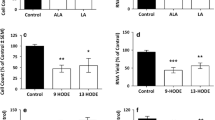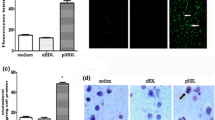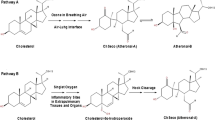Abstract
The growth of the necrotic core region within advanced atherosclerotic plaque is thought to be driven by oxidised low density lipoprotein (oxLDL)-induced death of macrophage cells. OxLDL and atherosclerotic plaque are rich in oxysterols, especially 7-ketocholesterol (7KC). As 7KC triggers cell death at physiological concentrations when added directly to the cell culture media, 7KC and other oxysterols have been suggested to be the main cytotoxic agent of oxLDL. We investigated this hypothesis by examining the toxicity of 7KC to monocyte-like U937 cells when incorporated into high-uptake non-toxic acetylated LDL (acLDL). Incorporation of 7KC into acLDL greatly reduced the oxysterol toxicity when compared with an equivalent amount of 7KC added directly to U937 cells. Enrichment of oxLDL with 7KC did not significantly enhance lipoprotein toxicity. OxLDL was highly cytotoxic yet generated only low levels of intracellular 7KC. In comparison, 7KC-acLDL generated high intracellular 7KC concentrations with little loss in cell viability. The data show that when incorporated into lipoprotein, 7KC cytotoxicity is greatly reduced, even though intracellular levels exceed those measured when cells are incubated with oxLDL, which suggests 7KC is not the significant toxic agent within oxLDL.





Similar content being viewed by others
Abbreviations
- acLDL:
-
Acetylated LDL
- oxLDL:
-
Oxidised low density lipoprotein
- 7KC:
-
7-Ketocholesterol
- HNE:
-
4-Hydroxynonenal
- HPLC:
-
High performance liquid chromatography
- MDA:
-
Malondialdehyde
- MTT:
-
3-(4,5-dimethylthiazol-2-yl)-2,5-diphenyl tetrazolium bromide
- PBS:
-
Phosphate buffered saline
References
Ball RY, Stowers EC, Burton JH, Cary NRB, Skepper JN, Mitchinson MJ (1995) Evidence that the death of macrophage foam cells contributes to the lipid core of atheroma. Atherosclerosis 114:45–54
Gieseg SP, Leake DS, Flavall EM, Amit Z, Reid L, Yang Y (2009) Macrophage antioxidant protection within atherosclerotic plaques. Front Biosci 14:1230–1246
Esterbauer H, Dieber-Rotheneder M, Waeg G, Striegl G, Jurgens G (1990) Biochemical, structural, and functional properties of oxidized low-density lipoprotein. Chem Res Toxicol 3:77–92
Gieseg SP, Pearson J, Firth CA (2003) Protein hydroperoxides are a major product of low density lipoprotein oxidation during copper, peroxyl radical and macrophage-mediated oxidation. Free Radic Res 37:983–991
Brown AJ, Jessup W (1999) Oxysterols and atherosclerosis. Atherosclerosis 142:1–28
Haberland ME, Olch CL, Folgelman AM (1984) Role of lysines in mediating interaction of modified low density lipoproteins with the scavenger receptor of human monocyte macrophages. J Biol Chem 259:11305–11311
Hoff F, O’Neil J, Chisolm GM, Cole TB, Quehenberger O, Esterbauer H, Jurgens G (1989) Modification of low density lipoproteins with 4-hydroxynonenal induces uptake by macrophages. Atherosclerosis 9:538–549
Clare K, Hardwick S, Carpenter KL, Weeratunge N, Mitchinson MJ (1995) Toxicity of oxysterols to human monocyte–macrophages. Atherosclerosis 118:67–75
Colles SM, Maxson JM, Carlson SG, Chisolm GM (2001) Oxidized LDL-induced injury and apoptosis in atherosclerosis—potential roles for oxysterols. Trends Cardiovasc Med 11:131–138
Larsson DA, Baird S, Nyhalah JD, Yuan XM, Li W (2006) Oxysterol mixtures, in atheroma-relevant proportions, display synergistic and proapoptotic effects. Free Radic Biol Med 41:902–910
Garcia-Cruset S, Carpenter KLH, Guardiola F, Stein BK, Mitchinson MJ (2001) Oxysterol profiles of normal human arteries, fatty streaks and advanced lesions. Free Radic Res 35:31–41
Brown AJ, Dean RT, Jessup W (1996) Free and esterified oxysterol formation during copper-oxidation of low density lipoproteic and uptake by macrophages. J Lipid Res 37:320–335
Gerry AB, Satchell L, Leake DS (2007) A novel method for production of lipid hydroperoxide- or oxysterol-rich low-density lipoprotein. Atherosclerosis 197:579–587
Yang L, Sinensky MS (2000) 25-Hydroxycholesterol activates a cytochrome c release-mediated caspase cascade. Biochem Biophys Res Commun 278:557–563
Berthier A, Lemaire-Ewing S, Prunet C, Monier S, Athias A, Bessede G, De Barros JPP, Laubriet A, Gambert P, Lizard G, Neel D (2004) Involvement of a calcium-dependent dephosphorylation of BAD associated with the localization of TRPC-1 within lipid rafts in 7-ketocholesterol-induced THP-1 cell apoptosis. Cell Death Differ 11:897–905
Gelissen IC, Brown AJ, Mander EL, Kritharides L, Dean RT, Jessup W (1996) Sterol efflux is impaired from macrophage foam cells selectively enriched with 7-ketocholesterol. J Biol Chem 271:17852–17860
Jialal I, Freeman DA, Grundy SM (1991) Varying susceptibility of different low-density lipoproteins to oxidative modification. Arterioscler Thromb 11:482–488
Brown AJ, Leong S, Dean RT, Jessup W (1997) 7-Hydroperoxycholesterol and its products in oxidised low density lipoprotein and human atherosclerotic plaque. J Lipid Res 38:1730–1745
Lizard G, Miguet C, Bessede G, Monier S, Gueldry S, Neel D, Gambert P (2000) Impairment with various antioxidants of the loss of mitochondrial transmembrane potential and of the cytosolic release of cytochrome c occurring during 7-ketocholesterol-induced apoptosis. Free Radic Biol Med 28:743–753
Baird SK, Hampton M, Gieseg SP (2004) Oxidised LDL triggers phosphatidylserine exposure in human monocyte cell lines by both caspase-dependent and independent mechanisms. FEBS Lett 578:169–174
Gieseg SP, Amit Z, Yang YT, Shchepetkina A, Katouah H (2010) Oxidant production, oxLDL uptake, and CD36 levels in human monocyte derived macrophages are down regulated by the macrophage generated antioxidant 7,8-dihydroneopterin. Antioxid Redox Signal 13:1525–1534
Gieseg SP, Esterbauer H (1994) Low density lipoprotein is saturable by pro-oxidant copper. FEBS Lett 343:188–194
Kritharides L, Jessup W, Mander EL, Dean RT (1995) Apolipoprotein A1 mediated efflux of sterols from oxidised LDL load macrophages. Atheroscler Thromb Vasc Biol 15:276–289
Mosmann T (1983) Rapid colorimetric assay for cellular growth and survival: application to proliferation and cytotoxicity assays. J Immunol Methods 65:55–63
Kritharides L, Jessup W, Gifford J, Dean RT (1993) A method for defining the stages of low-density lipoprotein oxidation by the separation of cholesterol and cholesterol ester-oxidation products using HPLC. Anal Biochem 213:79–89
Cotgreave IA, Moldeus P (1986) Methodologies for the application of monobromobimane to the simultaneous analysis of soluble and protein thiol components of biological systems. J Biochem Biophys Meth 13:231–249
Baird SK, Reid L, Hampton M, Gieseg SP (2005) OxLDL induced cell death is inhibited by the macrophage synthesised pterin, 7,8-dihydroneopterin, in U937 cells but not THP-1 cells. Biochim Biophys Acta 1745:361–369
Lizard G, Gueldry S, Sordet O, Monier S, Athias A, Miguet C, Bessede G, Lemaire S, Solary E, Gambert P (1998) Glutathione is implied in the control of 7-ketocholesterol-induced apoptosis, which is associated with radical oxygen species production. FASEB J 12:1651–1663
Monier S, Samadi M, Prunet C, Denance M, Laubriet A, Anne AA, Berthier A, Steinmetz E, Jurgens G, Negre-Salvayre A, Bessede G, Lemaire-Ewing S, Neel D, Gambert P, Lizard G (2003) Impairment of the cytotoxic and oxidative activities of 7 beta-hydroxycholesterol and 7-ketocholesterol by esterification with oleate. Biochem Biophys Res Commun 303:814–824
Gieseg SP, Reibnegger G, Wachter H, Esterbauer H (1995) 7,8-Dihydroneopterin inhibits low density lipoprotein oxidation in vitro. Evidence that this macrophage secreted pteridine is an antioxidant. Free Radic Res 23:123–136
Gieseg SP, Duggan S, Rait C, Platt A (2002) Protein and thiol oxidation in cells exposed to peroxyl radicals, is inhibited by the macrophage synthesised pterin 7,8-dihydroneopterin. Biochim Biophys Acta 1591:139–145
Leonarduzzi G, Vizio B, Sottero B, Verde V, Gamba P, Mascia C, Chiarpotto E, Poli G, Biasi F (2006) Early involvement of ROS overproduction in apoptosis induced by 7-ketocholesterol. Antioxid Redox Signal 8:375–380
Massey JB (2006) Membrane and protein interactions of oxysterols. Curr Opin Lipidol 17:296–301
Chisolm GM, Ma GP, Irwin KC, Martin LL, Gunderson KG, Linberg LF, Morel DW, Dicorleto PE (1994) 7-Beta-hydroperoxycholest-5-en-3-beta-ol, a component of human atherosclerotic lesions, is the primary cytotoxin of oxidized human low-density-lipoprotein. Proc Natl Acad Sci USA 91:11452–11456
Ermak N, Lacour B, Goirand F, Drüeke TB, Vicca S (2010) Differential apoptotic pathways activated in response to Cu-induced or HOCl-induced LDL oxidation in U937 monocytic cell line. Biochem Biophys Res Commun 393:783–787
Acknowledgments
This work was partly funded through a project grant from the National Heart Foundation of New Zealand and Student Research Support from the School of Biological Sciences, University of Canterbury. We would like to thank our blood donors for our source of blood and the Nurses from The Health Centre for carrying out the blood collection.
Conflict of interest
The authors have no conflict of interest.
Author information
Authors and Affiliations
Corresponding author
About this article
Cite this article
Rutherford, L.D., Gieseg, S.P. 7-Ketocholesterol is Not Cytotoxic to U937 Cells When Incorporated into Acetylated Low Density Lipoprotein. Lipids 47, 239–247 (2012). https://doi.org/10.1007/s11745-011-3634-1
Received:
Accepted:
Published:
Issue Date:
DOI: https://doi.org/10.1007/s11745-011-3634-1




